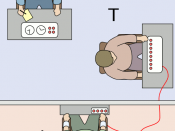In the 1960s, Milgram, then a professor at Yale, recruited ordinary people through a newspaper ad offering them money to help in a project purporting to improve human memory. In Milgrams experiment two people come into the laboratory where they are told they will be taking part in a study of memory and learning. Milgram was interested in how people obey under authoritative circumstances, using "fake" settings to test obedience. Under any given circumstance people tend to obey authority differently. Milgram tested this theory out by putting his volunteers into a laboratory setting and having them pressing a button shocking the other person for a wrong answer. Most of Milgram's volunteers went through the experiment, not wanting to disobey the authority figure. The volunteers in Milgram's experiment were fighting their subconscious minds. The person had complete power over the other individual, whom he could punish whenever he saw fit.
The subject had to decide if what they were doing was right (causing pain to another). This study suggests to me that, rightly managed, a cohesive group with an authoritative leader can find people who will do almost anything.
The thing I found interesting while reading about Milgram's Obedience experiment was the deception that took place. Right from the start, the subject was deceived by the motives of Milgram's experiment. It is not an experiment on the affect of electric shocks on learning, it was an experiment aiming to see how far the subject would be willing to go, when instructed by an authoritative figure. To me his experiment seems like one a doctor would use to determine the effects of a new drug on a group of people. While some are giving the real drug others are giving placebos or "fake" pills. In Milgram's experiment, people are led to...



Nice Summary
You do a nice job explaining Milgram's experiment and some of the implications but you should avoid using passive tense so often. Be sure about your writing and that your opinions are important and can be put into statements. : )
0 out of 0 people found this comment useful.